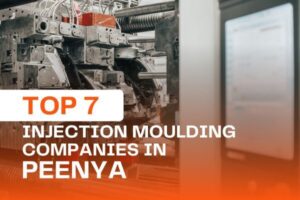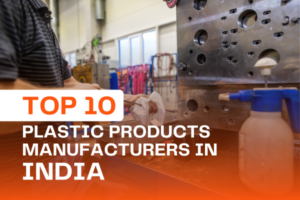Injection Mold (Explained with Components)
Injection molding is a widely used manufacturing process for producing plastic parts. It involves the creation of a mold that is used to shape molten plastic into the desired form. An injection mold consists of several components, each playing a crucial role in the molding process.
1. Mold Base: The mold base serves as the foundation for the entire mold structure. It is typically made of strong and durable materials such as steel or aluminum. Steel, particularly tool steel like P20 or H13, is commonly used for its high strength, wear resistance, and ability to withstand the stresses of the molding process. Aluminium is sometimes used for less demanding applications due to its lighter weight and better heat conductivity.
2. Cavities and Cores: Cavities and cores are the primary components that shape the plastic part.
- a) Core: The core is a component of the injection mold that forms the internal features and shapes of the molded part. It creates the hollow or internal space of the part, incorporating the desired dimensions, holes, and complex geometries. Its accurate alignment and fit with the cavity ensure the precise replication of the part's inner details and dimensions.
- b) Cavity: The cavity is an integral part of the injection mold responsible for forming the external features and shape of the molded part. Mounted on the movable side of the mold, it defines the outer surface, contours, and visible details of the final product. Cavity plays a critical role in determining the part's dimensions, surface finish, and any textures or patterns. Proper alignment and fit with the core enable the molten plastic to fill the cavity, resulting in the accurate replication of the desired part's external appearance and characteristics.
- They are usually made from hardened tool steels such as H13, S7, or P20. These steels offer high hardness, excellent wear resistance, and good thermal conductivity. For more demanding applications, premium grades of tool steel like D2 or M2 may be used.
- c) Runner: The runner is a channel through which molten plastic flows from the injection molding machine nozzle into the cavity. It distributes the molten material to multiple cavities in multi-cavity molds or directs it to a single cavity in single-cavity molds. The runner is typically designed to have a uniform cross-sectional area to ensure balanced filling of the cavities and consistent part quality. It is important to consider factors such as runner size, length, and shape to optimize material flow, minimize pressure loss, and reduce cycle time.
- d) Gate: The gate is the narrowest section of the runner system, where the molten plastic enters the cavity. It controls the flow rate and pressure of the material as it enters the mold cavity. The gate design and location are critical as they affect part quality, such as appearance, strength, and dimensional accuracy. Common gate types include sprue gates, edge gates, and sub-gates, each offering specific advantages depending on the part requirements and mold design.
- When designing the core and cavity of an injection mold, careful consideration is given to the placement and design of the runner and gate. Factors such as gate size, location, and type influence the flow pattern, filling characteristics, part quality, and overall mold performance.
- 3. Sprue Bushing: The sprue bushing is responsible for channeling the molten plastic into the mold. Since it experiences high temperatures and pressures, it is typically made from materials that can withstand these conditions. Common materials include hardened tool steels like H13 or stainless steel.
- 4. Locating Ring: The locating ring is a component in an injection mold that helps align and assemble the mold halves. It ensures precise positioning of the core and cavity for accurate part production. Commonly used materials for locating rings include tool steel and high-strength plastics, chosen for their durability and resistance to wear during the molding process.
- 5. Runner System: The runner system or feed system is responsible for distributing the molten plastic from the sprue to the cavities. It can be made from the same material as the mold base or from materials with good flow characteristics and wear resistance, such as aluminum alloys or stainless steel.
- 6. Ejector Pins: Ejector pins are commonly made from hardened steel, such as H-13 or D-2 tool steel. These materials offer high strength, wear resistance, and durability necessary to withstand the repeated ejection forces and maintain dimensional accuracy.
- 7. Ejector Plate: The ejector plate is typically made from a robust and rigid material to withstand the forces exerted during ejection. It is commonly constructed from hardened tool steel, such as P-20 or H-13, or from aluminium alloys for lighter applications.
- 8. Ejector Backing Plate: Ejector backing plates require strength and stability. They are commonly made from materials like steel or aluminium, depending on the specific requirements of the mold and the expected forces involved.
- 9. Ejector Retainers: Ejector retainers are often made from materials that provide good strength and rigidity while facilitating easy removal and replacement of the ejector pins. Common materials used include stainless steel, aluminium alloys, or engineering plastics such as Delrin or nylon.
- 10. Return Pins/Springs: Return pins are usually made from hardened steel to provide strength and durability. Springs used in the ejector mechanism are typically made of materials like stainless steel or high-strength alloys to ensure proper elasticity and longevity.
- 11. Cooling System: The cooling system consists of channels or passages within the mold that help extract heat from the mold and facilitate the solidification of the plastic. Cooling channels are typically made from materials with high thermal conductivity, such as copper alloys (beryllium copper or copper-beryllium-nickel alloys), to efficiently dissipate heat.
- 12. Venting System: The venting system allows for the escape of air and gases during the molding process. Venting channels or vents are usually made from materials that can withstand the molding conditions and promote proper venting. They are often made from hardened tool steels or stainless steel.
- 13. Guide Pins and Bushings: Guide pins and bushings ensure proper alignment and movement of mold components. These components require good wear resistance and low friction. Materials such as hardened tool steels, self-lubricating alloys like bronze or graphite-filled composites, or even ceramics can be used.
- 14. Mold Inserts and Lifters: Mold inserts and lifters are used for creating features such as undercuts or complex geometries in the molded part. They are typically made from materials that can withstand high temperatures, pressures, and repetitive movements. Tool steels, such as H13 or P20, are commonly used for their strength and wear resistance. In some cases, specialty materials like beryllium copper or hardened stainless steel may be employed.
- 15. Mold Date and Identification Inserts: Mold date and identification inserts are used for marking the molded parts with specific information. These inserts can be made from various materials, such as tool steel, stainless steel, or even plastics, depending on the specific requirements for marking.
The selection of materials for each component depends on factors such as desired mold life, molding conditions, part complexity, and budget constraints. Trumould’s Mold designers and manufacturers choose the appropriate materials based on their expertise and the specific requirements of the application.
In conclusion, an injection mold comprises various components that work together to shape molten plastic into a desired form. The materials used for these components are carefully selected Trumould to ensure durability, wear resistance, thermal conductivity, and other necessary properties for a successful injection molding process.




